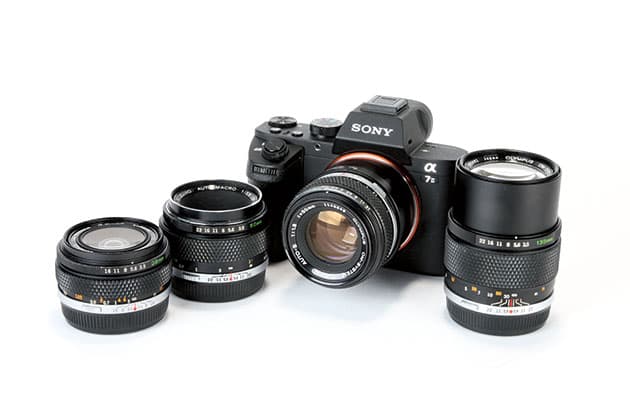Glass from the past, Andy Westlake tells us how to use classic lenses on modern mirrorless cameras.
Not so long ago, it was rare to find people using old manual-focus lenses on their cameras. It’s just not very practical with most DSLRs: few lenses can be adapted from one SLR mount to another, and doing so requires sacrificing the considerable convenience of automatic aperture operation. The small optical viewfinders of APS-C DSLRs make accurate manual focusing very difficult, and exposure metering often stops working reliably, too. Even with Nikon and Pentax cameras, which can mount older F or K mount lenses, there are myriad compatibility issues.
The advent of mirrorless cameras changed all this, and brought an explosion of interest in using older lenses. Initially, the motive was to bolster the small lens ranges that were available when new systems were introduced, but it rapidly became clear that these lenses are far easier to use with live-view cameras, as the image sensor itself is used for both focusing and metering. The ever- increasing usability of live view on DSLRs means that it’s more feasible than ever to use them with older optics, too.

Here my Olympus OM Zuiko 200mm f/4 gave me excellent sharpness and attractive bokeh, for a mere £70. Sony Alpha 7 II, Olympus 200mm f/4, 1/200sec at f/4, ISO 400
So, why might you do this? First and foremost, manual-focus lenses are cheap second-hand, especially those for long-dead SLR mounts such as Olympus OM, Canon FD, or Minolta MD. For example, you can often pick up a 50mm f/1.8 prime for less than £30, or a 50mm macro for under £100. So it’s a great way to experiment with new types of shooting on a budget.
Manual-focus prime lenses also tend to be impressively sharp, especially when stopped down, and they can also give really interesting bokeh effects with out-of-focus backgrounds. However, the same can’t necessarily be said of older zooms, which tend to be noticeably worse than their modern counterparts. They’re not unusable, but in general sticking with primes is a better bet.
Shooting with manual-focus lenses isn’t, however, quite as easy as using modern lenses with autofocus and image stabilisation. But if you pay attention to your technique and learn the qualities of your lenses, you should be able to get some great results.

Manual focus macro lenses can be found relatively cheaply. I shot this using an Olympus OM 50mm f/3.5 Macro that I bought for about £60. Olympus OM-D E-M5, 50mm f/3.5 1/160sec at f/5.6, ISO 1600
Using classic lenses – Kit list
- Camera Old lenses work best on mirrorless cameras: I use the full-frame Sony Alpha 7 II and Micro Four Thirds Olympus OM-D E-M5. It’s also possible to use DSLRs in live view.
- Lenses If you want to start buying old lenses to experiment with, it’s cheapest and easiest to choose one old, obsolete mount. I happen to use Olympus OM, but alternatives include Canon FD or Minolta MD.
- Mount adapters Adapters are simple devices, and cheap ones superficially look the same as more expensive versions. But the more you pay, the better machined they’re likely to be.
- Lens hoods Older lenses can often be more susceptible to flare, so it’s always best to use a hood. They come in a variety of materials and types.
- Spare batteries Mirrorless cameras tend to be more power-hungry than SLRs. The obvious solution is to make sure you always carry a couple of spare batteries when you’re out shooting.
Using classic lenses – Understanding the basics
The majority of the old lenses you can pick up second-hand were designed for use with 35mm film SLRs, so they’ll behave as they were originally intended when used on full-frame cameras. Most digital cameras, of course, have smaller sensors, and this imposes a field-of-view crop. If you mount a 50mm lens on an APS-C camera, it will give the same a field of view as a 75mm lens does on full frame, and on Micro Four Thirds it will behave like a 100mm lens.
This may sound obvious to experienced photographers, but it has a profound effect on the practicalities of using older lenses. If you have a nice set of old lenses you want to resurrect, then a full-frame Sony Alpha 7-series camera is the vehicle of choice. If you shoot with an APS-C camera then a 28mm or 35mm lens becomes a handy ‘normal’ lens and a 50mm f/1.8 or f/1.4 prime a nice portrait lens, but you’ll struggle to get a real wideangle. Meanwhile on Micro Four Thirds, old lenses are best used to gain ultra-telephoto reach, especially with the remarkable in-body image stabilisation on recent bodies (particularly from Olympus).
To use old lenses on a modern camera, you’ll normally need a mount adapter – essentially a metal tube with a mount to fit the camera body at one end, and another to accept the lens at the other. These almost invariably employ stop-down operation – in other words, rotating the lens’s aperture ring closes the diaphragm directly. This means you always view the image at the shooting aperture, effectively providing a full-time depth-of-field preview.
With no electronic connection to the camera, you won’t get any EXIF data in your images telling you the lens, focal length or aperture that you used. The camera won’t know you have a lens attached, either, and with many mirrorless models this will prevent the shutter from releasing. You’ll have to find a menu item called ‘Release without lens’ (or similar) and enable it.

Manual lenses are great for ultra-telephoto shooting on crop-sensor cameras. Here I used a Tamron SP 500mm f/8 mirror lens. Olympus OM-D E-M5 Mark II, Tamron SP 500mm f/8, 1/320sec at f/8, ISO 400
Using classic lenses – Focusing
When it comes to shooting with old lenses, you’ll need to pay attention to technique. To get the best results, you need to understand the various different focusing strategies you can use, and when each is most appropriate. At the simplest level, you can judge your focus simply by gauging when the image is sharp in the viewfinder, but this isn’t very accurate. However, most cameras provide a couple of focus aids to make your life easier.
First is magnified view, which is usually available at several zoom levels and with the ability to move the area of interest over your subject. This usually gives the most accurate focus possible, but it’s relatively slow to use, and gets increasingly difficult with longer lenses due to hand-shake, especially if your camera doesn’t have image stabilisation. Even so, it’s my most-used focus method, and I assign it to a function button for easy access.
Second is focus peaking, where the camera highlights high-contrast edges of the image with a coloured outline: red, yellow or blue. This is much quicker to use than magnified view, but less precise. It tends to be most effective with lenses that have relatively shallow depth of field: telephotos or fast primes. Most cameras offer different strengths of peaking, with higher levels suitable for softer, lower-contrast lenses.
As mentioned earlier, most adapters stop the lens down to the taking aperture as a matter of course. This means that you’re not necessarily focusing wide open, and sometimes this isn’t the best idea. For example, when I’m shooting at small apertures, I sometimes open up a couple of stops for focusing, to judge better the point of sharpest focus on the subject.
If you shoot with fast primes, you might also find them hard to focus at maximum aperture. In fact, it can be really disconcerting to see just how hazy many old fast primes can be wide open, as a result of spherical aberration. In such cases, even if you want to shoot at maximum aperture for creative effect, it can be a good idea to stop down a bit for focusing, to cut through the aberrations and find the best focus point.
Of course you can, if you like, use the lens’s distance and depth-of-field scales to judge focus, and this can be particularly effective with wider lenses for subjects such as street photography. If you’re using a mount adapter, though, it’ll need to be precisely the right length for this approach to work effectively – which won’t necessarily be the case with cheap brands. It’s also crucial to understand that depth-of-field scales on lenses are calculated for a specific film format, and if you’re using 35mm lenses on an APS-C camera, you’ll need to close the aperture down by an extra stop to get the desired depth of field. On Micro Four Thirds, you’ll need to select an aperture that’s two stops smaller.
Using classic lenses – How to clean up images
While a lot of old lenses are very sharp, they’re not free from aberrations. But if you shoot raw, some of the most visible defects can be corrected in post-processing, in a fashion that was simply impossible with film. Let’s look at how this is done, using Adobe Camera Raw (Lightroom has all the same tools). Other programs provide similar options.

Lateral CA: Green and magenta fringing is visible in this corner segment of an image

CA corrected: It can be removed simply by clicking ‘Remove Chromatic aberration’
Chromatic aberration takes two forms – lateral and longitudinal. The former shows up as complementary-coloured fringing around high contrast edges that’s strongest towards the corners of the frame; it can be suppressed by clicking ‘Remove Chromatic Aberration’ in the Lens Corrections palette (see above). The latter is fringing around out-of-focus elements, and tends to be most visible with fast primes or telephotos. To remove it, experiment with the Defringe control in the Manual tab (see below).
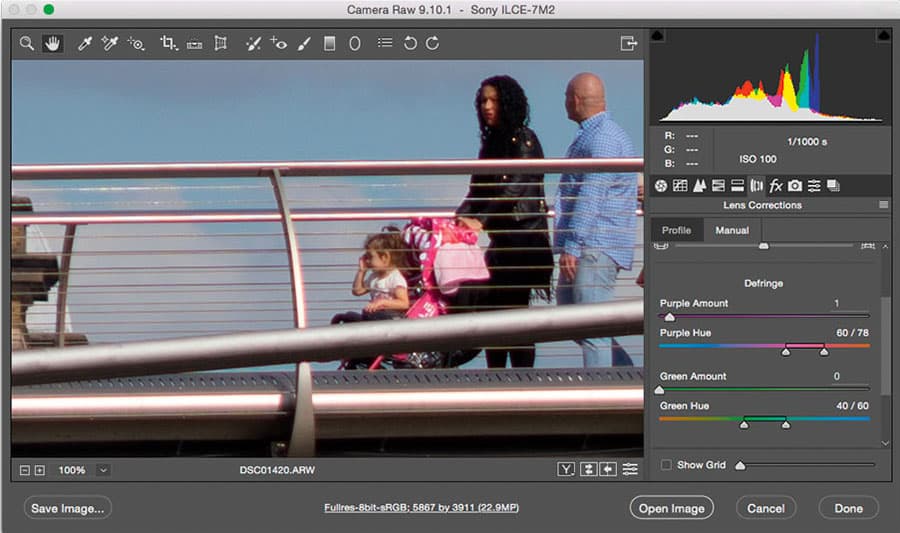
Longitudinal CA: This type of fringing can be suppressed using the Defringe controls
Distortion is the bending of straight lines towards the edges of the frame, which will typically be of the barrel type with wideangle lenses, and pincushion with telephotos. It usually only has to be corrected with certain geometric subjects such as architecture. For a prime lens, the distortion will be the same for every single shot, so you only need to work out the right value to enter once.
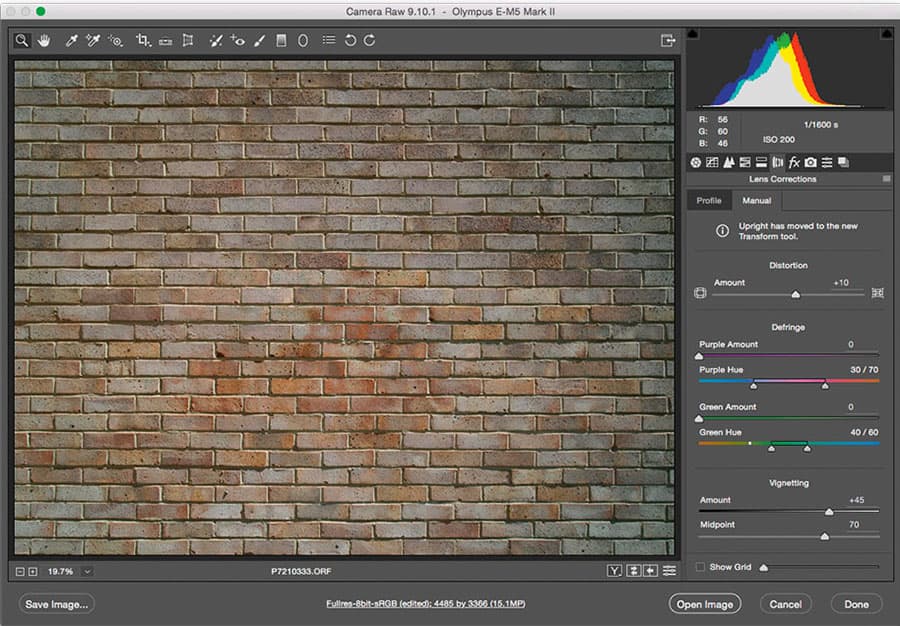
Distortion: Brick wall shots are ideal for judging how to set distortion correction
Full-frame lenses generally show very little vignetting when used on cameras with smaller sensors: the darker corners are simply cropped away. But if necessary it can also be reduced using the Amount and Midpoint sliders. The latter adjusts for how gradually vignetting progresses across the time; setting a small value corrected for the gradual fall-off typical of fast primes, while a large value deals with the abrupt drop in brightness in the corners sometimes seen with zooms.
If the lens you’re using is soft – for example, a fast prime at a large aperture – then careful use of the sharpening controls can tease out the maximum possible detail. It’s also well worth experimenting with the clarity control to enhance local contrast – in particular when making relatively small prints.
If you take all these principles into account, from shooting through to processing, then you should be able to get the best from your lenses. In fact, you might be surprised just how good image files you can get from surprisingly inexpensive optics. Learning to use manual focus and aperture operation can also kindle new kinds of creativity in your photography, and hopefully you’ll also have fun along the way.
Using classic lenses – Shooting technique
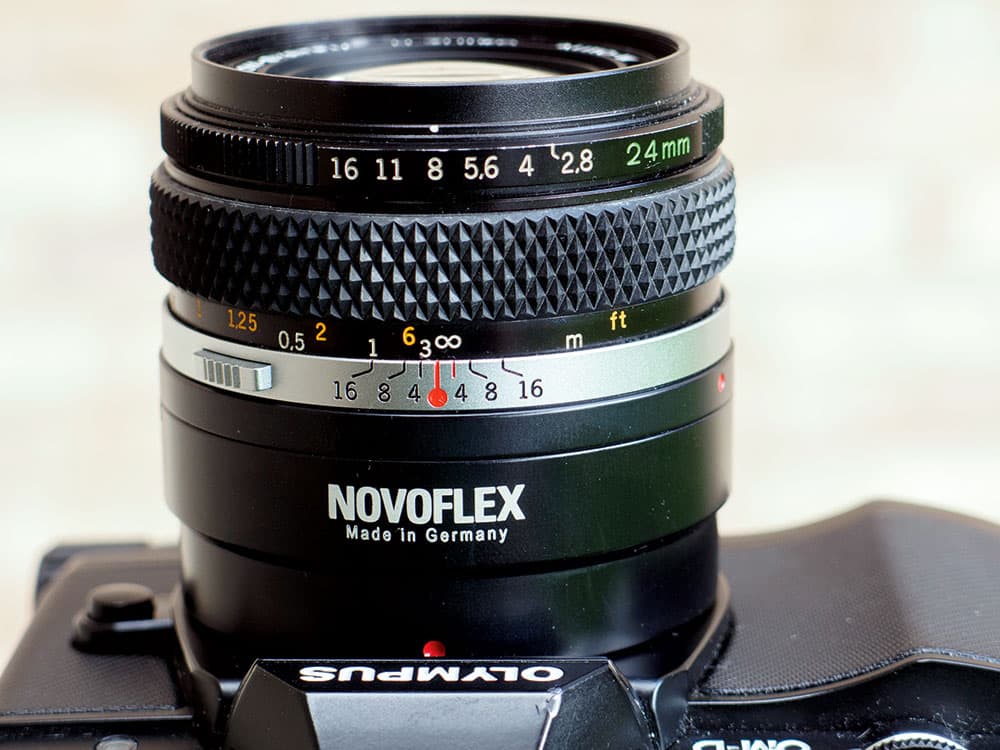
To get the best results with old lenses, you’ll need to use proper technique
1. Aperture selection
For sharpest results, it’s usually best to close the aperture down a stop or two to suppress aberrations. However, going too far will cause excessive diffraction blurring. The optimum aperture depends on your camera’s sensor size; I’d usually avoid going beyond f/8 on Micro Four Thirds, f/11 on APS-C, and f/16 on full frame.
2. Shutter speed selection
With a lot of cameras, you won’t get image stabilisation, so be sure to select a high enough shutter speed to avoid blur. Employ the 1/equivalent focal length rule as a minimum; for example with a 100mm lens on APS-C, use at least 1/160sec. To be absolutely sure of sharp images, go a stop faster.
3. Don’t be afraid of high ISO
A grainy image is almost always far better than a blurred one. So don’t be afraid to raise the ISO to get a fast enough shutter speed or small enough aperture.
4. Use a lens hood
Older lenses are usually less effectively coated than modern ones, which makes them more susceptible to flare, particularly from light hitting the front element obliquely. So be sure to use a hood, which will also protect the front element.
5. Don’t use UV filters
When using older lenses on digital, UV or protective filters simply add to the risk of flare. Unless I need to protect the lens from spray or dust, I don’t use them.
6. Shoot raw
You won’t get any in-camera lens corrections when shooting JPEGs, so you’ll see such things as curvilinear distortion and colour fringing due to chromatic aberration. But if you shoot raw, you can correct these in post-processing.
Testing lenses
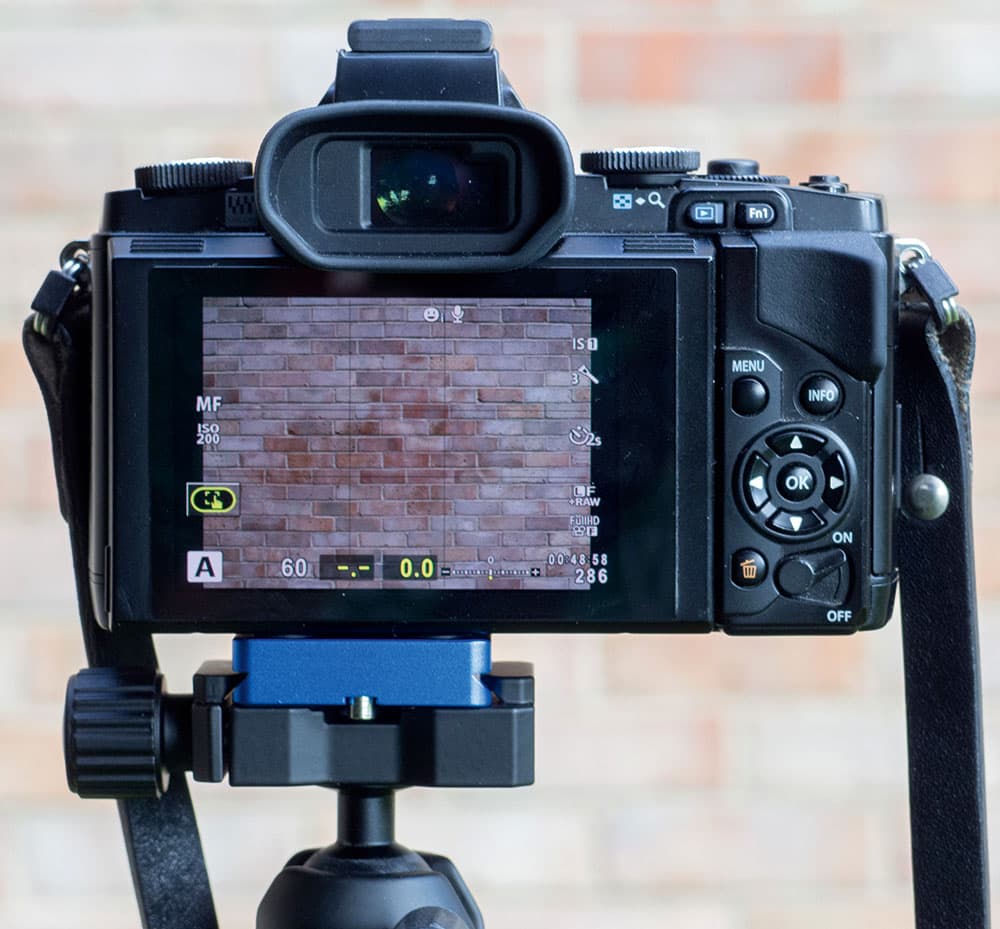
To get the best from your lenses, it helps to understand their optical characteristics, such as which apertures are sharpest. You can test this using a subject that has detail across the frame, such as a landscape or, if you’re feeling less imaginative, a brick wall. Mount the camera on a sturdy tripod, set it to its lowest ISO, turn on the self timer, focus using magnified view, then shoot a series of frames across the aperture range. Bear in mind that if you use the same lens on cameras with different sensor sizes, the optimum aperture is likely to be different for each.
Using in-body IS
If you have a camera with in-body stabilisation, you’ll have to manually enter the focal length of the lens you’re using for it to work properly. This is fine with primes, but if you use zooms, it’s easier to turn IS off.
- On Panasonic cameras with in-body stabilisation, the camera prompts you to specify the focal length when you turn it on.
- On Sony cameras, first locate the SteadyShot Settings menu item, then adjust the SteadyS Focal Len value to match your lens. I prefer to assign this to a custom button for one-touch access. Sony’s in-body works well at focal lengths up to about 200mm, but becomes increasingly less effective with longer telephotos.
- On Olympus cameras, things are more convoluted. Press the OK button to access the onscreen Super Control Panel, enter the IS option lower left, and press the Info button to access the focal length selection setting. Fortunately, recent cameras including the PEN-F and OM-D E-M1 Mark II have a short cut – they allow you to program the camera with the names and focal lengths of your lenses. You can then set a Fn button to recall your lens list: selecting one then sets the IS system, as well as adding the lens name to the EXIF data.
Related reading:

